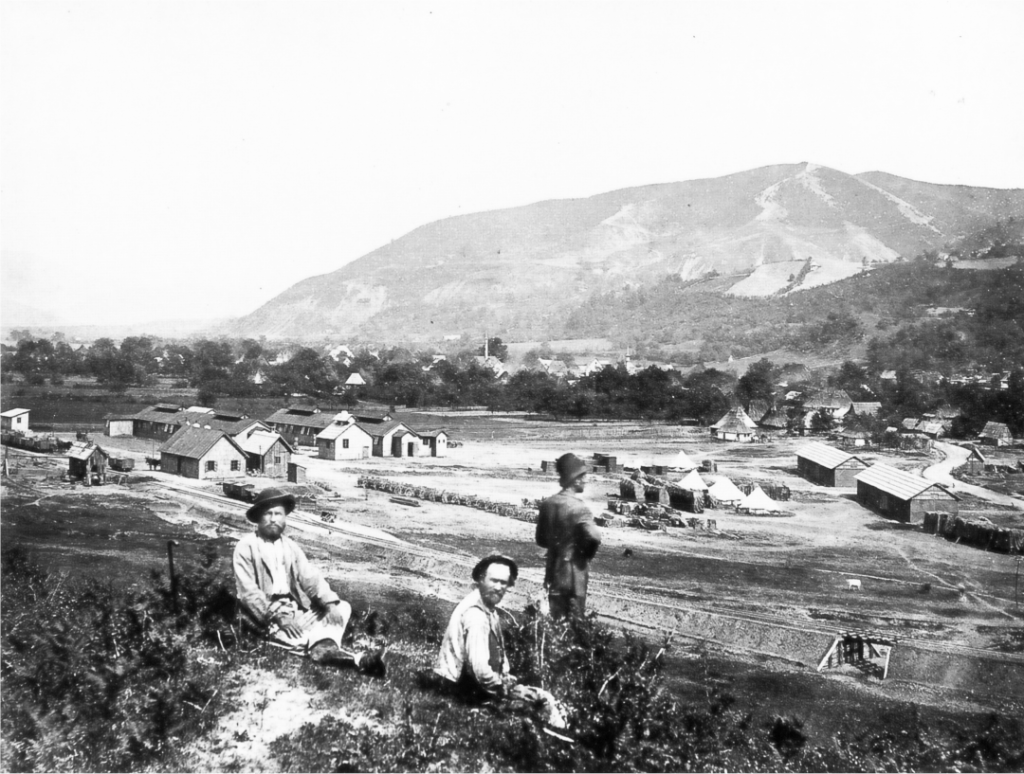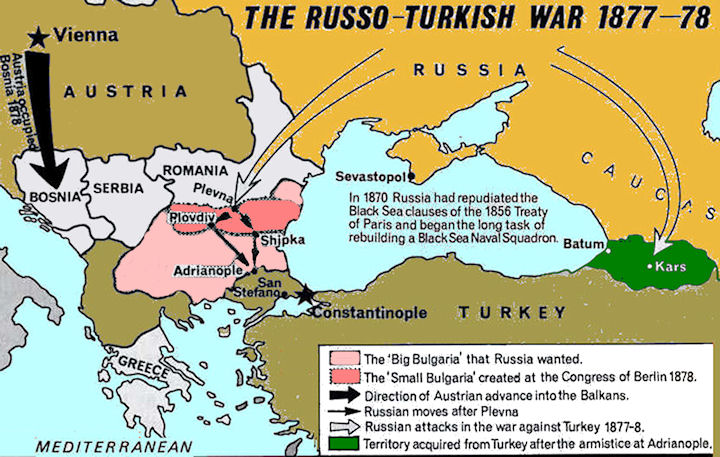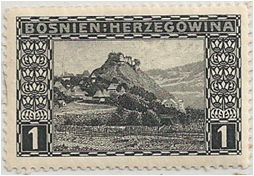ALBUM – view my Austro Hungarian Occupation of Bosnia & Herzegovina album
Fast Facts
Region: Balkans
Group: Austro Hungarian Occupations
Classification: Military Occupation (Austria Hungary)
Prior Regime: Ottoman Empire
Key Dates:
1878, July – Treaty of Berlin, results in Austro-Hungarian control over Bosnia & Herzegovina
1878, Oct – Austro-Hungarian military assumes full control of Bosnia & Herzegovina
1908 Oct 6 – Austria Hungary annexes Bosnia
1909, April – Treaty of Berlin amended to reflect annexation
Following Regime: Province of Austria Hungary
Scott Catalogue: (Bosnia & Herzegovina) 1-45, J1-J13
Pick Catalogue: none
History

Bosnia and Herzegovina, a former kingdom in the western Balkans, fell to the advancing Ottoman Empire in 1463, and for more than 400 years was under the control of the Ottoman Turks. Following the defeat of the Ottomans in the Russo-Turkish War of 1877-78, the Congress of Berlin was organized in 1878 which resulted in the Treaty of Berlin and a rebalanced the power structure in the Balkan region. Bulgaria was established as an independent principality inside the Ottoman Empire and Eastern Rumelia and Macedonia was returned to the Turks. Romania, Serbia and Montenegro obtained independence, Britain took over Cyprus, and Bosnia and Herzegovina was assigned to the become a ”protectorate” of Austria-Hungry while technically remaining under Ottoman sovereignty. While an agreement was made, no one was happy with the results, damaged many national relationships and created tensions among the Great Powers of Europe. These events set the region on a path which saw multiple wars, and ultimately the start of World War 1 with the 28 June, 1914, assassination of the Archduke and Archduchess of Austria (heirs to Austro-Hungarian throne) by a Serb nationalist in Sarajevo.

When Austria-Hungary was awarded control over Bosnia and Herzegovina in the Treaty of Berlin, it was not readily accepted by the local populous. The Austro-Hungarian Army met significant opposition, and many hard battles were fought, however occupation was secured in October of 1878. Tensions and dissent remained high, especially within the Muslim population, where they were losing their privileged status based on their religion.
Over the coming years, Austria-Hungary introduced many changes to the region, such as codified laws, new political practices and modernization. They attempted to set up a multicultural state among the various religions and ethnicities (e.g. Serbian Orthodox, Croat Catholics and Bosnian Muslims), while maintaining the feeling that they were part of a great nation. Although the region was fairly successful economically, these changes were not enough to suppress the ethnic pressures from within, and from its various neighbors.
With a continued rise if nationalism within the region, the idea of a unified Slavic State (instigated by the Kingdom of Serbia), became a popular idea. As tensions continued to rise, on 6 Oct, 1908, Emperor Franz Joseph, announced to the people of Bosnia-Herzegovina, his intention to fully annex the nation into the Austro-Hungarian Empire. This caused what is known as the ”Bosnian Crisis”, which created great angst among various powers across Europe. Reluctantly, the Treaty of Berlin was amended in April 1909, accepting the new status. While the immediate crisis was brought to an end, most historians believe that this annexation ultimately set off the events which lead to World War 1 five years later.
Stamps
 ALBUM
ALBUM
The first two series of stamps from Bosnia & Herzegovina (issued 1879 and 1900 respectively) featured the coat of arms of double headed eagles, and only the value was indicated. This was due to the political situation in the occupation, and the various languages and alphabets in the region. The 1879 issue had the value at the top, and the 1900 issue at the bottom of the stamps. Various perforations exist, and reprints for many of the stamps were printed in 1911, all in slightly different shades and with a 9-1/2 perforation.
In 1906, Bosnia Herzegovina replaced the Coat of Arms stamps by issuing a new series of 16 pictorial stamps featuring various national landmarks across the region. The engraved stamps, were inscribed “BOSNIEN HERZEGOWINA”, and values ranged from 1 heller to 5 kronen. As with some of the Austrian Empire postage stamps of this time, there are many different production varieties of these new Bosnia Herzegovina definitive stamps, with a large multitude of perforation combinations. Some of these varieties were actually intentionally created for presentation to government officials and influential stamp collectors of the time.
Also in 1906, a set of 13 postage due stamps were issued.
Banknotes
Austro Hungarian banknotes were used during the occupation.
Links
Bosnia and Austro-Hungarian Rule
The Bosnian Crisis at the History Learning Site
Bosnia & Herzegovina at Stamp Collecting World
Bosnia & Herzegovina: Profusion of perforations – Stamp Magazine
Bosnia & Herzegovina – from Big Blue 1840 – 1940





I have a stamp bearing the following words:
ZEMALJSKA VLADA ZA BOSNU IZA HERCEGOVINU
The stamp value is 1 Novig. It is white with red lettering.
It seems to have something like Arabic script along the bottom.
I’m trying to find out the date and value of this stamp.
Can you help? I find no reference in most catalogues.
I can send a scan if I can find an email
Thanks
Ian
Hi Ian
Without seeing a scan, I believe that this is a revenue stamp from Bosnia and Herzegovina. “ZENAKHSJA VKADA” is Bosnian for “Local Government”. Assuming that this is the case, this was discussed on Stampboards and you can link here.
Michael
I really like your website on the Dead Countries- in fact, I’ve added it to my Great Stamp Blogs/Websites on my own classical era blog. 🙂
What is appealing about Dead Countries is they have a beginning and an end, and often the history is thick indeed.
I particularly find your extensive history section on the Dead Country posts to be extremely informative.
And the pictures and the maps evoke the times.
Look forward to your next post!
Jim
Hi Jim
Thank you so much for your complement. As stated in my intro, the history is indeed facinating, and I too like the idea of having a finite about of material to collect. Having visited your site several times, I find it extremely helpful and a nice resource for classic era stamps. I will also add your site: http://bigblue1840-1940.blogspot.com/ to my list of helpful references.
Over time, I will continue to add countries to my site, and maybe one day it will be as useful as yours.
Michael